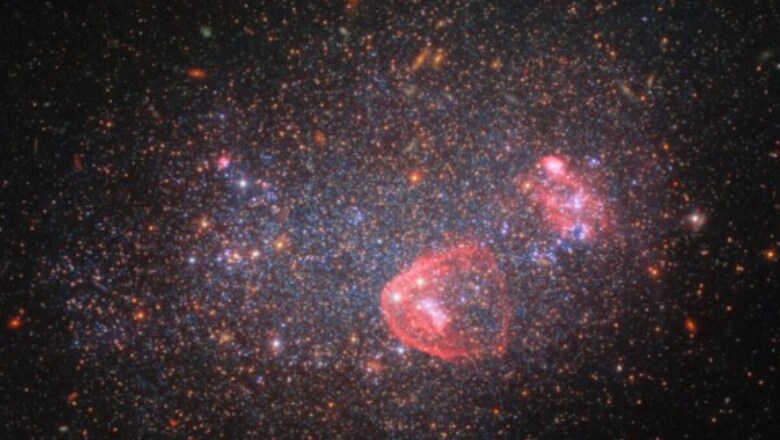
views
In a celestial gift just in time for the holiday season, NASA has revealed a stunning image of a galaxy resembling a sparkling snow globe. The extraordinary galaxy, named UGC 8091, is situated approximately 7 million light-years away from Earth, nestled in the same direction as the constellation Virgo in our night sky.
The captivating image results from data collected by NASA and the European Space Agency’s Hubble Space Telescope over several years. Unlike familiar spiral galaxies like Andromeda or the Milky Way, or the smooth elliptical shapes of neighbouring galaxies, UGC 8091 boasts a more unconventional and scattershot structure, classifying it as an “irregular” galaxy. Irregular galaxies, which make up about a quarter of all observed galaxies, lack a distinct spiral arm structure or a central bulge.
The billion stars in the dwarf galaxy UGC 8091 make it resemble a sparkling snow globe in this festive Hubble image. The stars that make up this celestial gathering look more like a brightly shining tangle of string lights than a galaxy: https://t.co/luA7afg8aw pic.twitter.com/yZ9YJRUHSN— Hubble Space Telescope (@HubbleTelescope) December 20, 2023
Among the cosmic oddities, the Small Magellanic Cloud, a close galactic neighbour located 199,000 light-years away, also falls into the category of irregular galaxies.
Typically smaller in size, often only about one-tenth of the Milky Way’s size, irregular galaxies showcase peculiar shapes resulting from tumultuous events during their formation. These events may involve interactions with other galaxies or collisions with massive clouds of gas and dust.
UGC 8091 is additionally classified as a dwarf galaxy due to its smaller size. Hubble has been diligently exploring dwarf galaxies across the cosmos to shed light on their role billions of years ago, immediately after the Big Bang. Theorized to have played a significant role in re-heating hydrogen that had cooled off during the universe’s expansion, dwarf galaxies contribute valuable insights into the early stages of our cosmic history.
The enchanting snow globe-like image of UGC 8091 was composed using data gathered by Hubble’s Wide Field Camera 3 and the Advanced Camera for Surveys between 2006 and 2021. This mesmerising composite includes 12 camera filters capturing various types of light, spanning from the red end of the light spectrum to ultraviolet light. The red patches in the image represent hot, excited hydrogen gas in newly formed stars, while the other lights signify the presence of older stars, painting a vivid picture of the diverse celestial activities within this unique galaxy.




















Comments
0 comment